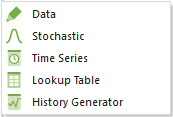Courses: Introduction to GoldSim:
Unit 2 - Basic Concepts
Lesson 4 - Elements: The Basic Building Blocks of a GoldSim Model
Elements are the fundamental building blocks of a GoldSim model, and each type has a particular symbol or graphical image by which it is represented on the screen. You give each element a unique name by which it is referenced (e.g., X, Revenue, Rainfall, Discount_Rate).
GoldSim provides a wide variety of elements, each of which serves a different purpose. Some of these elements provide a mechanism for the user to enter input data into the model. Other elements represent functions which operate on one or more inputs and produce one or more outputs. Two special classes of elements (Stocks and Delays) are critical for generating the dynamics in your models.
There are six general categories of elements in GoldSim:
- Input elements define the basic inputs to a model.

- Stock elements compute outputs by numerically integrating other model variables with respect to time. Examples of a Stock include the volume of water in a pond (which would integrate inflows and outflows over time), or the distance travelled by a car (which would integrate the car’s velocity over time).

- Function elements compute outputs based on the current values of the outputs of other elements. The simplest and most general function element (referred to as an Expression) is similar to a cell in a spreadsheet, allowing you to create mathematical expressions. Other Function elements carry out more complex or specialized calculations.

- Event elements represent the occurrence and consequences of discrete (“sudden”) events in a model (e.g., a storm occurs, a switch is turned on, a deposit is made to a bank account).

- Delay elements simulate processes that take a specified amount of time and hence result in a delay in transmitting material, information or signals in a model (e.g., the movement of material on a conveyor belt, waiting in line at a security checkpoint or store).

- Result elements collect, analyze and display results.

An additional type of element, the Container, is used to hierarchically organize other elements.
We will discuss most (but not all) of these elements in detail throughout this Course.
